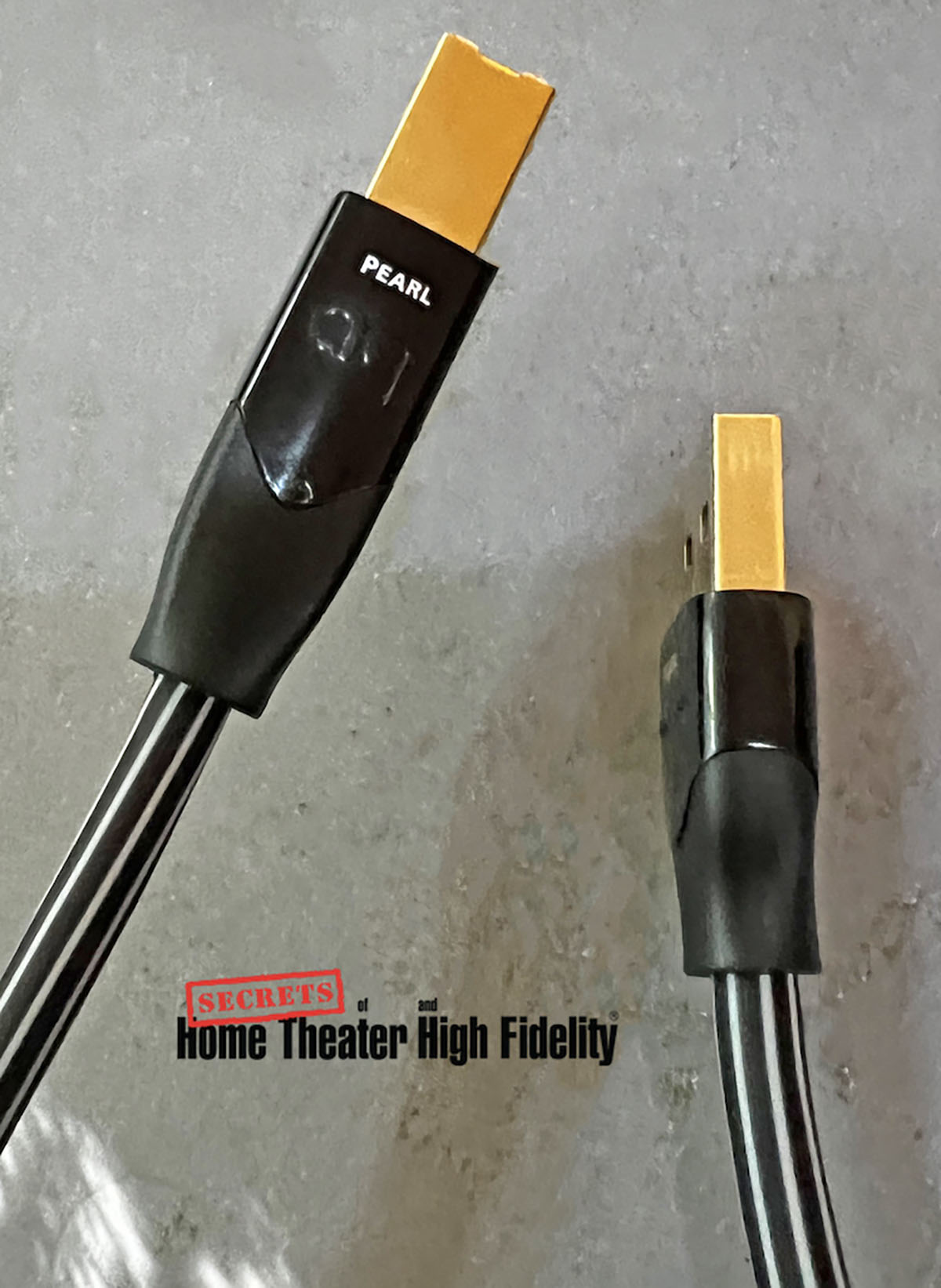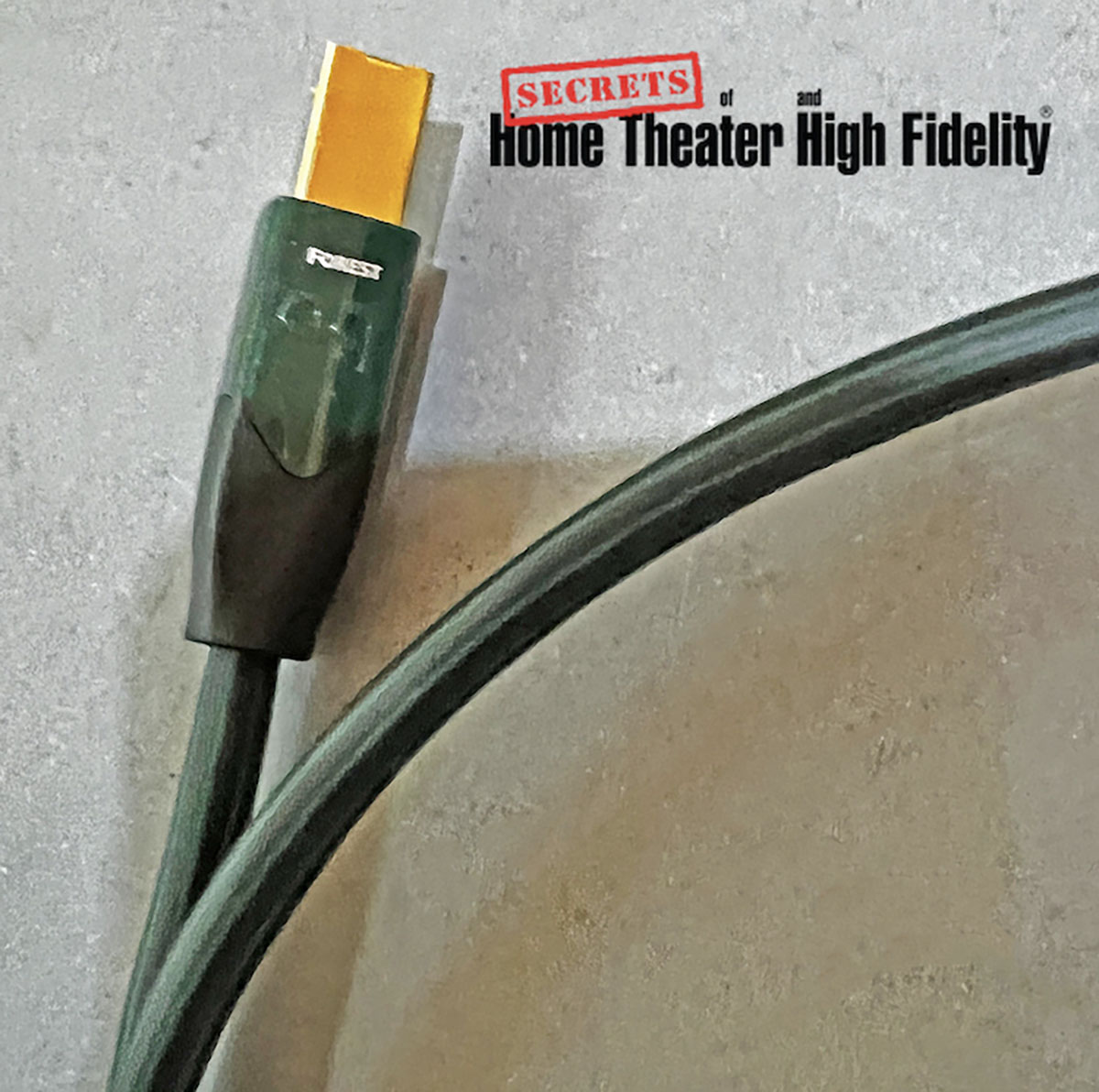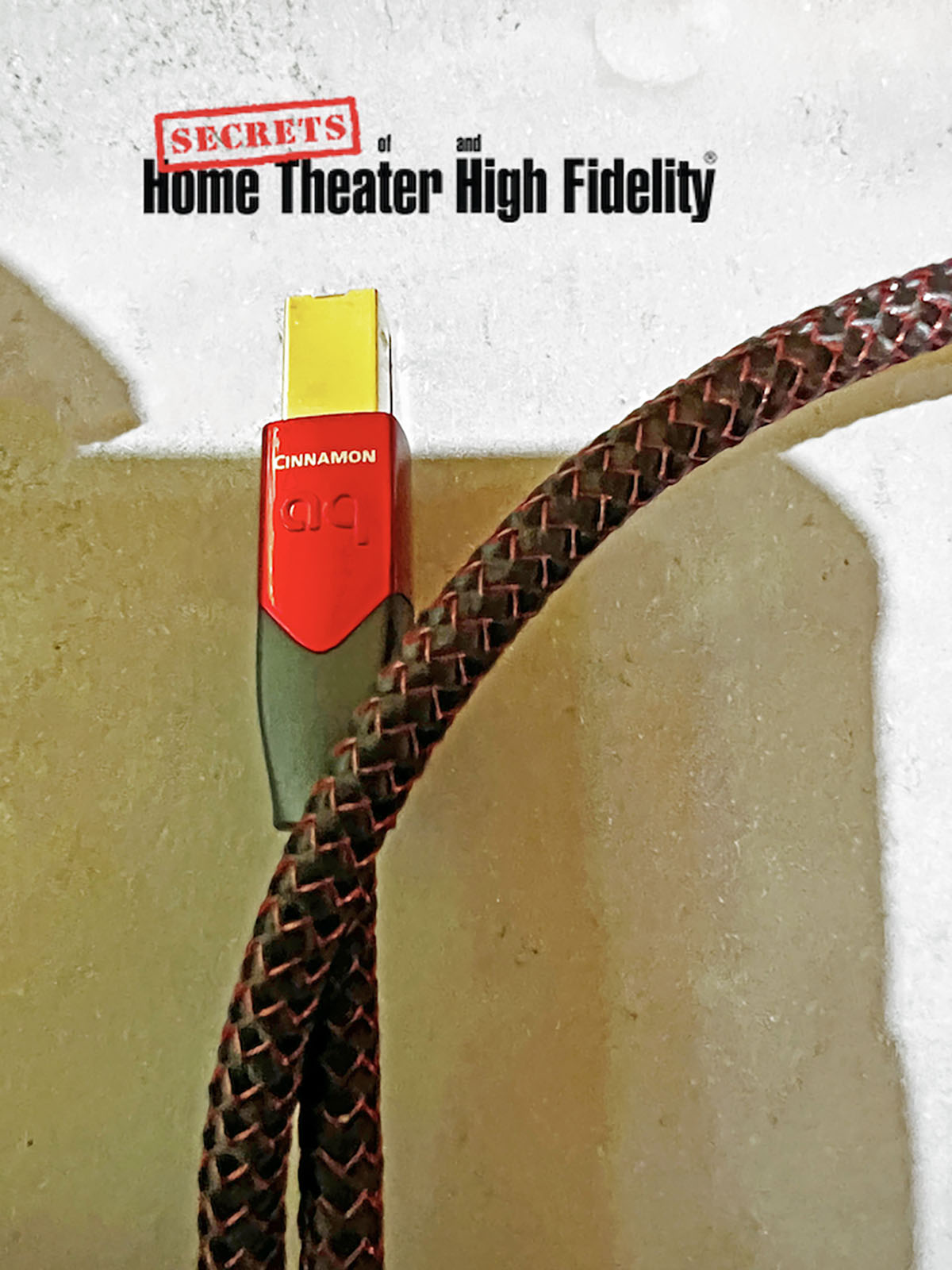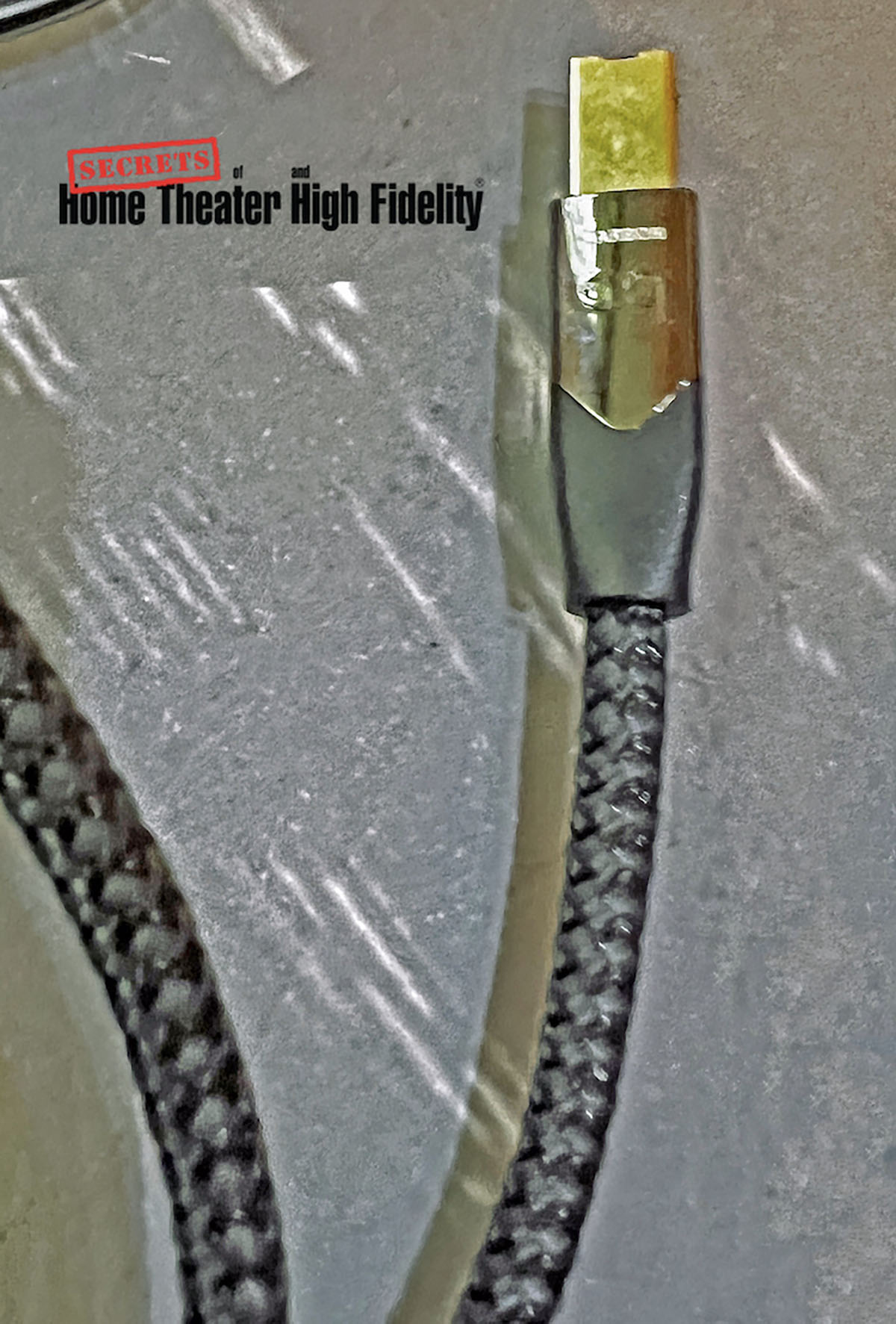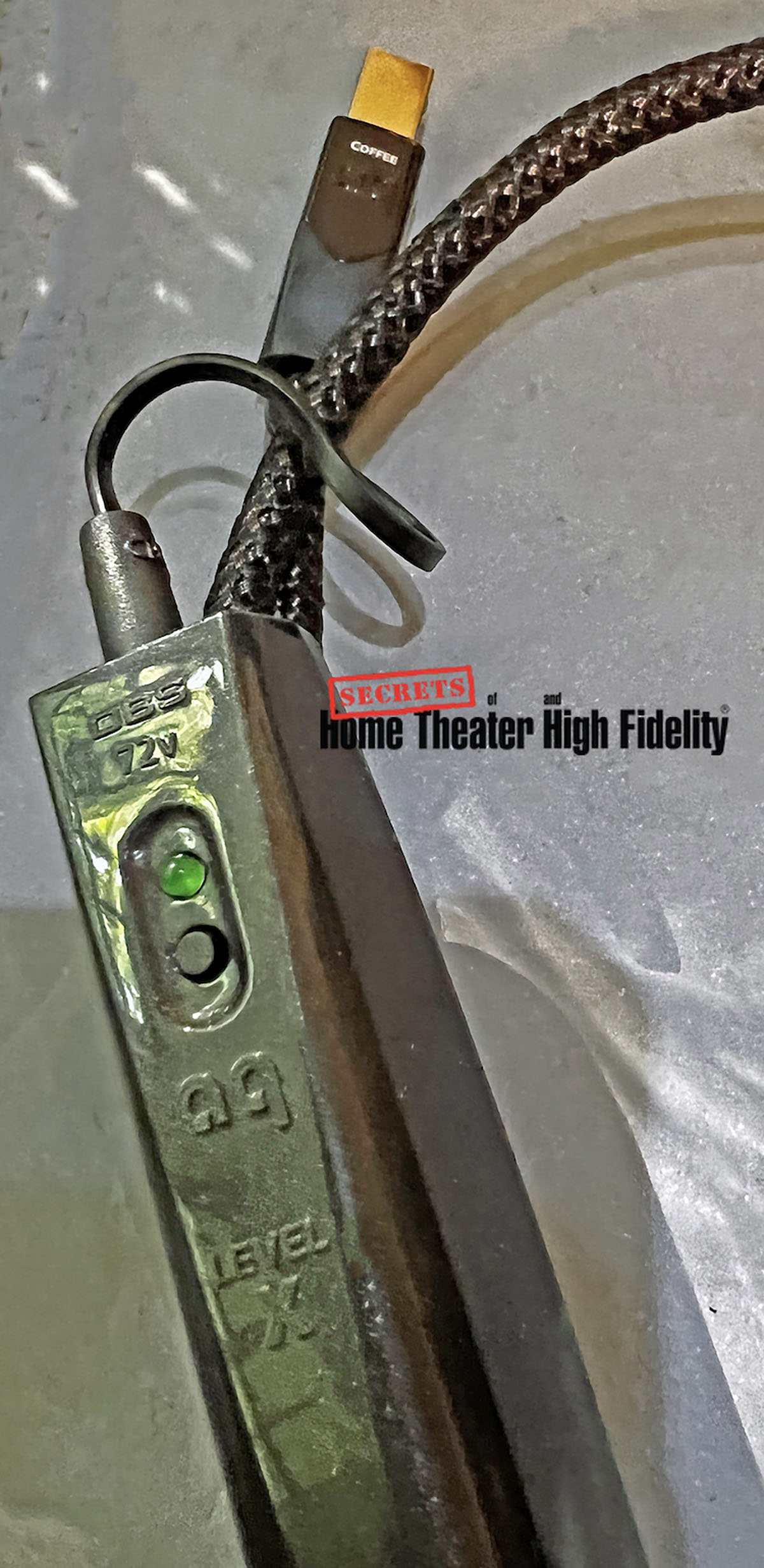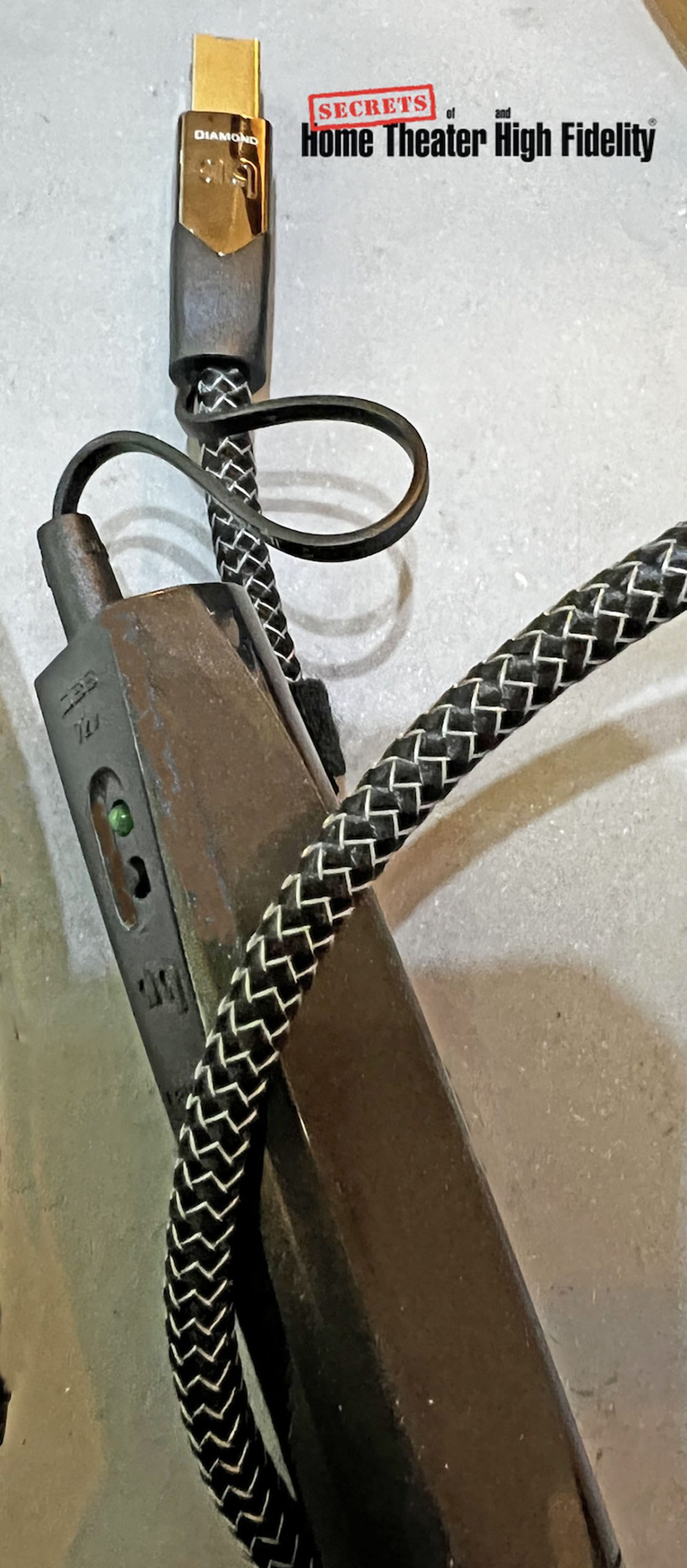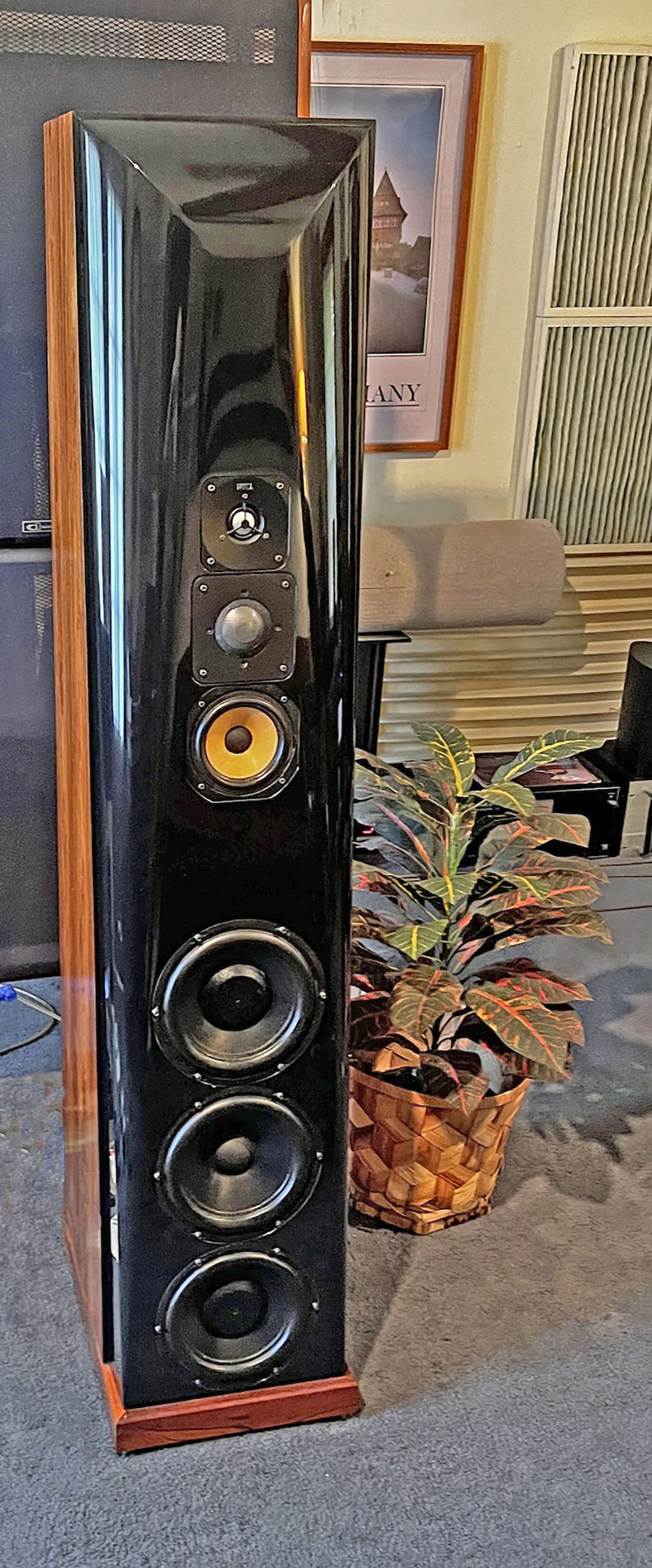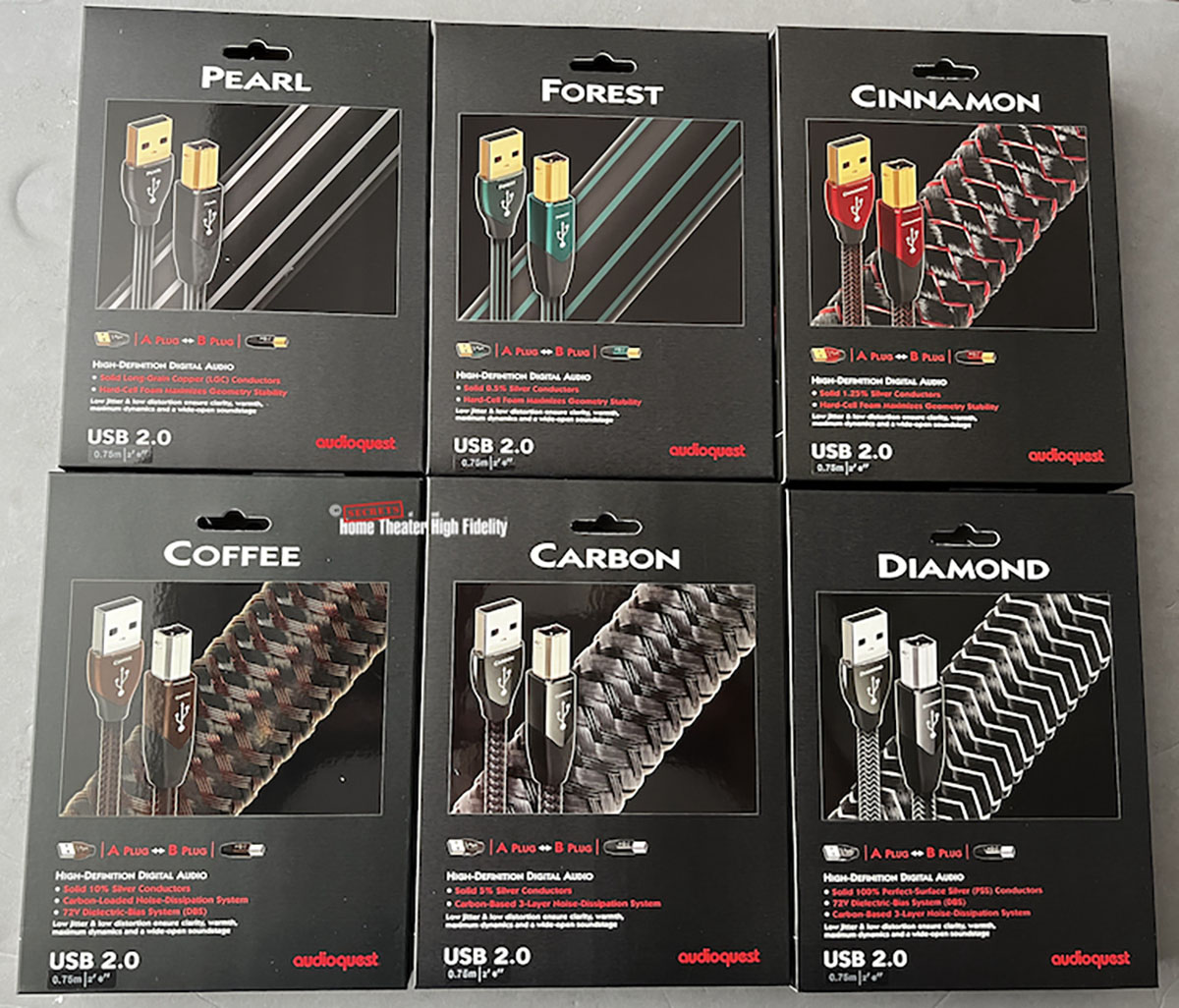These AudioQuest USB models come with different amounts of silver content, from zero to 100% pure “Perfect Surface” silver. The top two models, the Coffee and the Diamond offer AudioQuest’s 72-Volt Dielectric-Bias System (DBS). Do USB cables make audible differences? Read on!
AUDIOQUEST USB CABLES
- AudioQuest offers a wide variety of USB cables
- Those cables come in a variety of terminations (USB 2.0 A to 2.0 B in this test)
- Those cables come at a variety of price points
- Performance varies depending on the associated components
- Some systems may benefit from these AudioQuest products
For less than the cost of a business lunch, you can get an AudioQuest Pearl USB cable. Before I ever thought of doing this review, I had bought one for my system and thought it an improvement. Prior to the Pearl, I’d been using an old printer cable for the computer-to-DAC connection and the wires that came with my disc player and external HDD for the other digital connections. At that time, I didn’t even know that AudioQuest made other USB cable models. When I found out, I became curious as to what one might get for higher prices. Though I don’t think that digital cables make as much of a difference as analog ones, they can be useful to put the finishing touches on a top-notch system.
So, let’s stir up the anthill…
Digital data transfer is a done deal. There are algorithms that compare what was sent with what was received, eliminating the possibility of noise affecting the digits unless interpolation is required. In audio gear, at the receiving end, the data stream is buffered and reclocked so there can be no transmitted timing errors. Each and every transfer is absolutely bit-perfect. If the source bits and the destination bits are identical then by definition, the music files MUST sound absolutely and completely identical. Period. End of discussion.
Digital interconnects (of ANY type – optical, coaxial, USB, etc.) either function or they don’t. There is no real “in between.” If a bit-perfect copy is made from a source, then the interconnect did its job. If the interconnect did not do its job, then you won’t have a bit-perfect copy. Period. End of discussion.
Based on the previous two paragraphs, it makes no sense to spend a penny extra on digital interconnects. If a Wal-Mart, Monoprice, or Amazon cable does the job, why spend more? You might prefer a specific length or a specific insulation color but other than that, then by definition they MUST all sound the same. Period. End of discussion. Yes?
Not so fast, hot rod… The next question that must be asked is: “Are the computer algorithms that are perfectly sufficient for data transfer also adequate for music?” This question broadens into several different segments:
- Do we understand digitization and how it affects music?
Most would argue that via the Nyquist theorem we know most of what’s available and the rest is being studied.
- Do we understand digital data transmission and is it sufficient for music?
Most would argue that since this can be readily measured, this is the segment that we know the most about (and the segment under consideration in this review).
- Do we understand the playback conversion of digital music data streams and how they affect the final analog signal?
Most would argue that we know much of what’s available and the rest is being studied.
- Do we understand the propagation of acoustic signals in air?
Most would argue that we understand acoustics perfectly (the sound signal in air).
- Do we understand the interface between the brain and the acoustic signal in air?
Most would agree that this is the segment that we know the least about. Our “understanding” of how the brain perceives acoustics is still the wild, wild West. And I offer a common experience to prove it: You’re walking down a noisy downtown street with traffic and other noises all around you. And you hear music from some blocks away. Your brain KNOWS instantly whether that music is live or recorded. No question – no chance of error.
What measurement accounts for this?
It isn’t frequency response or phase – the urban environment with buildings all around creates such a multipath environment that those measurements are moot. It isn’t dynamics – the combination of distance, echoes, and traffic/crowd noises mask any such evaluation. Yet we can TELL. Not only instantly but also with absolute certainty every single time.
Intellectually, I understand all the “facts” regarding digital cables presented at the start of this review. Yet, when comparing digital interconnects my (respected and knowledgeable) audio amigo, Russell, contends that digital interconnects sound different from one another. Several psychological issues affect claims such as his:
- Expectation bias occurs when an individual’s expectations about an outcome influence their perception.
In other words, if one expects a more expensive audio product to sound better, this is expectation bias.
- Hindsight bias is the tendency, upon learning an outcome of an event to overestimate one’s ability to have foreseen the outcome.
If indeed, a more expensive audio product does turn out to sound better, the expectation bias is confirmed and becomes stronger.
- Placebo effect is a beneficial effect produced by a placebo that cannot be attributed to the properties of the placebo itself and must therefore be due to the user’s belief.
If a less expensive audio product is substituted for a more expensive one without the listener’s knowledge, the listener, believing that they’re still hearing the “better” product, may believe that the sound is better.
- Conscious biases are known social stereotypes about groups of people.
If some individual or some group that we respect or admire claims that an audio product is superior, we tend to believe them because we respect the source.
Despite our biases, the brain’s response to music is more subtle than we give credit for. And even minor changes in audio such as varying interconnects – either analog or (gasp) digital, may be more audible than previously thought.
This hypothesis will be violently rejected by those who can conceive of no scientific theory that might explain it. I offer no such theory because I don’t have one. This report will be a commentary on what I hear (sans any theories on why I hear it). If you’re uncomfortable with such qualitative analysis, then feel free to seek other, more quantitative reviews.
Mr. Amir from audiosciencereview.com can (and has) proven in comparative null tests that there are no differences between USB cables. Yet, do these measurements mean that no differences exist? If even one listener can reliably and repeatedly hear differences, then differences do exist. Statistically, the single listener’s answer is insufficient for “proof,” but practically, the fact that differences exist is undeniable.
I suspect that I am unlikely to hear any differences in USB cables (despite Russell’s claims to the contrary). I give remote credence to the idea that differences in digital cables might be audible only due to my “conscious bias” and respect for Russell. But enough psychology – I will report what I hear. I may or may not hear differences, but I’ll honestly say whether I do or don’t. What I hear is what you get.
AudioQuest has been generous enough to loan the entire range of their USB cables for this comparison test, knowing in advance that I may well report that their most expensive cable sounds no different (or at least no better) than their cheapest one. That shows not only bravery but also corporate confidence in their products (that corporate confidence also contributes to my conscious bias).
I will try AudioQuest USB cables in three different locations:
- Between the CD reader and my computer while ripping discs
- Between the external USB HDD and my computer while both writing and playing files
- Between my computer and my DAC while playing files
Each cable will be a 0.75-meter USB-A to USB-B model with different metallurgical compositions.
The cables supplied by AudioQuest for this comparison include the following (all prices are MSRP at the time of this review):
Pearl (long-grain copper):
$39.95
Forest (0.5% silver):
$64.95
Cinnamon (1.25% silver):
$89.95
Carbon (5% silver):
$169.95
Coffee (10% silver):
$369.95
Diamond (100% silver):
$649.95
Warranty:
AudioQuest offers a 1-year warranty on each of the above.
Website:
Company:
SECRETS Tags:
AudioQuest, USB cable, Cable review, 2022, Pearl, Forest, Cinnamon, Carbon, Coffee, Diamond, Glenn Young, Reviews 2022
FIBBR Alpha USB audio cable review
I asked AudioQuest for construction details on their USB cables, and they were generous enough to share the following information with me:
Secrets Sponsor
Mr. Bill Low designs AudioQuest USB cables to use a single, solid conductor per pin. The conductors are wave soldered to the terminals and should not be prone to galvanic corrosion. The silver content is applied as a plating on the exterior of the copper conductor strands.
Some cable shields are woven of multiple strands to comply with USB standards. On each of the cable terminations, conductive, carbon-infused PVC insulators are used with multiple RFI shields. Conductors are oriented for high efficiency in draining RF energy away from the critical signal path.
For those cables (Coffee and Diamond) that use the 72-volt Dielectric Bias System (DBS), the insulation is also a dielectric that can act like a shunt-filter. Voltage biasing minimizes dielectric noise and linearizes the filter, creating a wide-bandwidth dissipation of induced radio frequency noise. The batteries in the DBS will last for several years and can be checked at any time by pushing the button on the DBS box. If the green LED fails to flash, battery replacement is indicated.
My system includes:
- Memorex MRX-550LE V.1 Multi-Format DVD recorder (used as a CD reader)
- Mac Mini OS-X running J.River Media Center V. 24 as ripping software and Roon software for music playback
- Seagate Barracuda 7,200 RPM HDD in a SATA external USB playback cradle
- iPad running Roon Remote for system playback control
- Emotiva Stealth DC-1 used as DAC and balanced preamplifier with remote volume
- AudioQuest Diamondback XLR cables from DAC to power amplifiers
- Emotiva PA-1 monophonic power amplifiers (class-D with B&O ICE modules)
- StraightWire speaker cables from power amplifiers to speakers
- Modified Klipsch RP-600m loudspeakers on 29” stands
- StarkeSound S15 sealed subwoofer
To avoid environmental variability, I implemented the following habits during testing:
- Cables were plugged into the same two USB sockets on the computer
- Cables were dressed identically so that any EMF from the rack wiring would affect each cable identically
- To avoid having subtle volume differences affect listening evaluations, the entire system was calibrated within +/- 0.25 dB (limits of my testing equipment) using pink noise and a calibrated UMIK-1 microphone before each playback audition.
For listening, I have chosen two songs that I’ve heard (figuratively) a million times. Both are well recorded, have wide frequency response, and have a wide dynamic range.
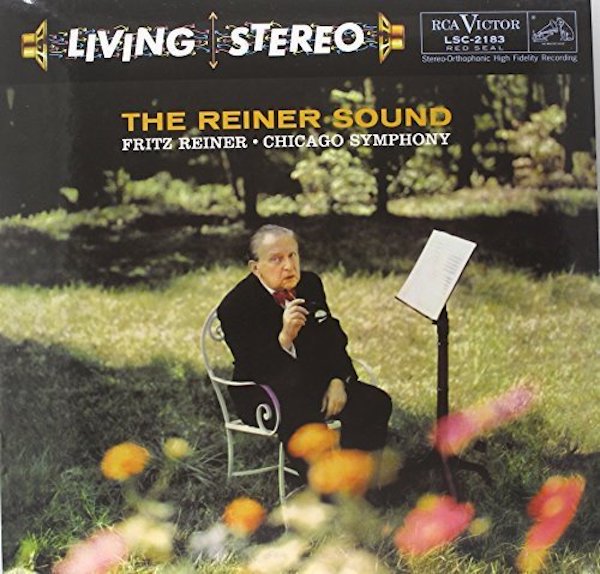
Franz Liszt “Totentanz”
My first test song is “Totentanz” by Franz Liszt. The performance is by Fritz Reiner and the Chicago Symphony. The RCA Living Stereo source disc is a remastered version of the original recording. The disc, “The Reiner Sound,” is OK, overall, but the Totentanz track is exceptional, in my opinion.
Totentanz offers an unusually wide dynamic range – the piano solos by Byron Janis are so low in volume that you’ll be strongly tempted to turn up the volume to hear them better. But should you do so, be prepared to scramble for your remote to turn down the volume as soon as the orchestra returns. There are cymbal crashes that should jump out of your speakers and startle you. There are kettle drums that you should feel in your chest cavity. Overall, despite the original 1958 recording, remastering has turned this into an excellent test track.
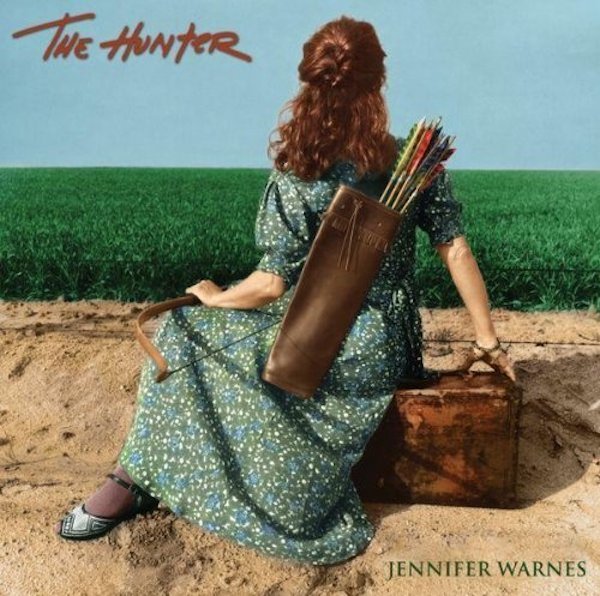
Jennifer Warnes “The Hunter”
My second test song is “Lights of Louisianne” by Jennifer Warnes from “The Hunter” CD. This is a delicate track where transparency and detail are important.
Secrets Sponsor
I bought replacement copies of both discs to ensure that no surface scratches or disc damage could affect the rips. The Jennifer Warnes disc was the gold-plated import, Impex Records 0899360002010.
Rips of the test tracks were made to my external USB HDD, one rip with each set of USB cables. The ripping was done with the same test cables installed between the DVDRW player and the computer and between the computer and the external HD.
After the rips were completed, the test cable between the DVDRW player and the computer was removed and then reinserted (for playback) between the computer and the DAC.
Thus, from source disc to playback, the same model of USB cable was used in every digital transfer:
- CD reader to computer (disc ripping)
- Computer to USB HDD (file writing while disc ripping)
- USB HDD to computer (file playback)
- Computer to DAC (file playback)
I’ll state right now that I thought that I did hear differences. So, with no further ado, off to the races (let the arguments begin)!
These are all-copper cables and seem somewhat better made than what one might get from discount suppliers. The sound of these cables will be my “baseline” for this comparison, and I’ll arbitrarily assign it a 5 out of 10 rating for that reason. But 5 out of 10 does not mean that this cable sounds mediocre. Ratings, by the way, are for the sound quality of each cable, ignoring the price.
I thought that the Pearl cables offered a very full tone from top to bottom. On “Totentanz,” the bass was OK, as was the imaging. On “Lights,” the bass seemed fuller, Jennifer’s voice seemed suitably “breathy,” and the crickets that end the song were clearly audible.
I think that the Pearl cables are justified in just about any digital audio system. I liked the Pearls better than my previous printer cable and thought that the Pearls “opened up” the top end of my system with more extension (but not by increasing treble amplitude or adding etching/glare).
On “Totentanz,” there seemed to be less imaging outside the speakers than with the Pearl cables. On “Lights,” there was more bass than the Pearl cables offered, Jennifer’s vocal vibrato was more audible, and the “breathiness” heard with the Pearl cables was apparent here as well, but the cricket ending seemed lower in amplitude.
I really liked the upper midrange resolution that the Forest cables seemed to bring to the party, the upper treble, maybe not so much. But overall, if your speakers already have a strong high-treble extension, and need a touch more bass, the Forest cables might be the ticket.
I’d give the Forest cables a 5.5 out of 10 rating.
On “Totentanz,” the soundstage was wider than with the Pearls, but the tone didn’t seem as rich. On “Lights,” the bass sounded more prominent than with the Pearls, but there was less “breathiness” to the vocal. The crickets were about the same as with the Pearls.
On my system, the Cinnamon cables just weren’t knocking me out. They did have a wider soundstage and more bass than the Pearls, but I just wasn’t wowed…
I’d give the Cinnamon a 5 out of 10 rating.
On “Totentanz,” I thought these had the best bass and a rich tone from top to bottom. On “Lights,” I thought that the breathy sound of Jennifer’s voice was clearly apparent.
Of the cables I heard, I think that I liked the Carbon cables the best. They had all the virtues of the entry-level Pearl cables but had tighter bass and a midrange “bloom” that I liked on my system. The bass tone and tightness sounded really good.
I’d give the Carbon cables a 6 out of 10 rating.
These are the first cables in AudioQuest’s lineup that include their “72V Dielectric-Bias System (DBS). Frankly, I didn’t hear much difference between these and the Pearl cables. These did have a full tone on “Totentanz” and also did a fine job with “Lights,” but they didn’t sound different enough from the Pearl cables to impress me.
If you need a richer tone due to the dry sound of your solid-state electronics, the Coffee cables may add some wetness. But since my system sounds fine (and not solid-state), I’m just not that impressed with the Coffee cables.
I’d give the Coffee cables a 4.5 out of 10 rating.
These are the other cables in AudioQuest’s lineup that use the DBS box. I didn’t like their bulk, but I did think that they sounded good. On “Lights,” I thought they had excellent transparency but slightly soft bass. The crickets that end the song were clear and present. On “Totentanz,” I thought that the soundstage was the best of the cables I heard.
For soundstage and transparency, I bump these Diamond cables to a tie for first place with the Carbon ones. These didn’t win outright because of their bass.
I’d give the Diamond cables a 6 out of 10 rating.
| CABLE MODEL | |||
|---|---|---|---|
| Carbon (5% silver @ $169.95) | |||
| Diamond (100% silver @ $649.95) | |||
| Forest (0.5% silver @ $64.95 | |||
| Pearl (0% silver @ $39.95) | |||
| Coffee (10% silver @ $369.95) |
I was surprised that I could hear differences but note that all of these USB cable ratings are very close together. Note also that these rankings are with my stereo, in my room, and to my ears. I think I heard the differences I’ve listed, but I also feel pretty certain that in an ABX test (using my equipment and in my room), I could probably not hear these differences with an 8 out of 10 success rate. YMMV.
To verify what I heard, I asked my audio amigo, Russell, to listen to the same USB cables in his (significantly higher resolution) system. I have known Russell for decades, and his ability to wring the highest performance out of his components is exceptional. Russell has earned his living in the audio industry, and I’ve found over the years that our agreement on what we hear is very close. His comments are included below. He did not get to read my comments before producing his. Russell’s system consists of:
- TASCAM DA-3000 with SD card RW at 24-96 resolution – This unit includes both a recorder and file player.
- Rosewell external USB enclosure with Western Digital 7200rpm Black drive
- Microsoft Surface Book with USB docking station running Windows 10
- Black Ice Fx Audio tube DAC
- Remote-controlled passive volume control housed in a former JOLIDA JD 5T case
- J.River Media Center 23 OR Db PowerAmp OR Exact Audio Copy for Windows for ripping and playback
- Dahlquist DQ-1LP crossover modified with Tiffany jacks
- Crown PSA-2 power amplifier with modified input jacks and an IEC connector power cord (for main speakers)
- Thiel CS5i speakers
- Iverson Eagle 2 power amplifier for dual 10-inch subs
- Crown / RTR passive subwoofers
- Polk Cobra Cable Litz wire for main speakers
- Colombian 16 ga. solid-core Romex for woofers
Russell tells me that the AudioQuest USB cable differences he hears affect primarily the midrange and treble regions of the audio spectrum, and that the three less-expensive AudioQuest USB cables sounded somewhat brighter, drier, and more etched in his system than the three cables at the top of the AudioQuest line.
Additionally, he says that the three top cables (the Carbon, Coffee, and Diamond) seem to have more midrange bloom in his system, with the edge perhaps going to the Coffee model. He also says that he thinks the most important USB connection for best sound quality is the one between the external music library hard drive and the playback computer.
| CABLE MODEL | |||
|---|---|---|---|
| Coffee (10% silver @ $369.95) | |||
| Carbon (5% silver @ $169.95) | |||
| Diamond (100% silver @ $649.9)5 | |||
| Pearl (0% silver @ $39.95) | |||
| Forest (0.5% silver @ $64.95) |
AudioQuest offers a wide range of well-made and well-engineered USB cables at varying prices. Somewhere in the lineup, you’ll probably find a model that fits your needs.
- Wide variety of cables and prices
- All are well-made and should last
- Multiple lengths are available to meet your needs
- Good company and trustworthy warranty
- Models with multiple Litz cable strands
- Ultrasonic welding of connectors
- Trade-up program within the AudioQuest line
USB cable performance differences may, indeed, be audible in some audio systems, but the differences may also be small. Differences are also virtually certain to be system dependent. Although Russell and I didn’t agree on rankings, you could just buy the most expensive Diamond USB cable and expect it to sound at least good and maybe excellent in all systems. Both Russell and I found the Diamond USB cable in a tie for top sound.
But what sounds the best in your friend’s system, or mine, or Russell’s may be equaled or even surpassed by a less expensive cable in your system. If you aren’t willing to invest the time and effort, or if you aren’t sufficiently confident in your ears to know what you want in terms of the balance of tone, imaging, bass, midrange, and treble, then just buy the top of the line and rest easy. But if you’re willing to listen, you may be able to invest the money you save on USB cables elsewhere. AudioQuest recommends that you use the least expensive cable that makes the greatest improvement in your system.
So, if you’re totally familiar with the sound of your system and are looking to add the last degree of performance to the audio playback from digital sources, it may be time to audition some USB cables. They may be able to make an audible musical difference.
This gets really hard. If you already have high-resolution components in an acoustically treated room, then it could be to your advantage to start comparing USB cables. If you’re at that point, I’d think that AudioQuest USB cables would be some of the ones I’d want to audition simply because they have such a wide variety to choose from. Mr. Bill Low’s AudioQuest USB cables are also reasonably priced compared to much of their “high-end” competition. It also doesn’t hurt that the brand is so widely available.
On the other hand, if your room lacks acoustic treatment, if your electronics are less than stellar, or if your speakers are not up to scratch, I think your money might be better spent on hardware rather than on the more expensive USB cables.
Despite the previous paragraph, I would absolutely and unequivocally recommend the AudioQuest Pearl cable as a reasonable purchase in any system at their bargain price and as a replacement for generic USB wires. If nothing else, you could be comfortable with the assurance that the AudioQuest USB connection is NOT the weak point in your digital music system.
If I were going to spend more than the price of the basic Pearl cables for my current system, my second choice would be the Carbon cables. I thought the Diamond cables sounded very marginally better than the Pearl and equal to the Carbon in my system, but at their price point, they make little sense for me.
Although not addressed in this review, USB cable length may have a significant impact on sound. If you have a DAC that is sensitive to grounding, noise, or timing, then USB cable length may be worth experimenting with. In general, shorter is better.





